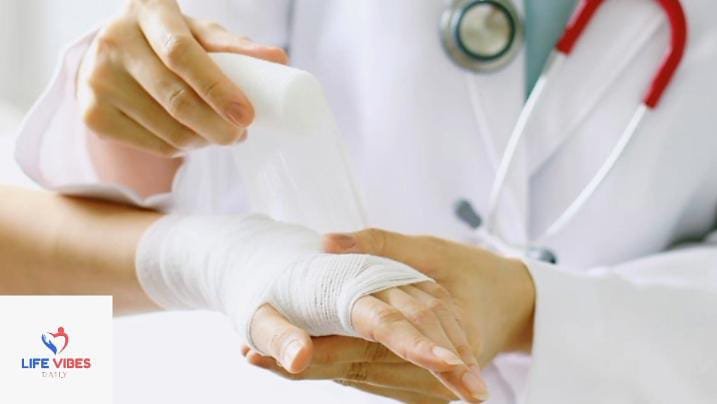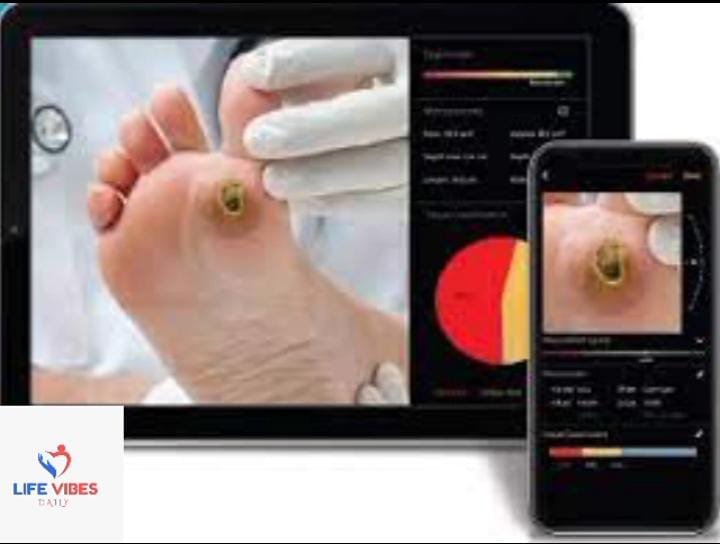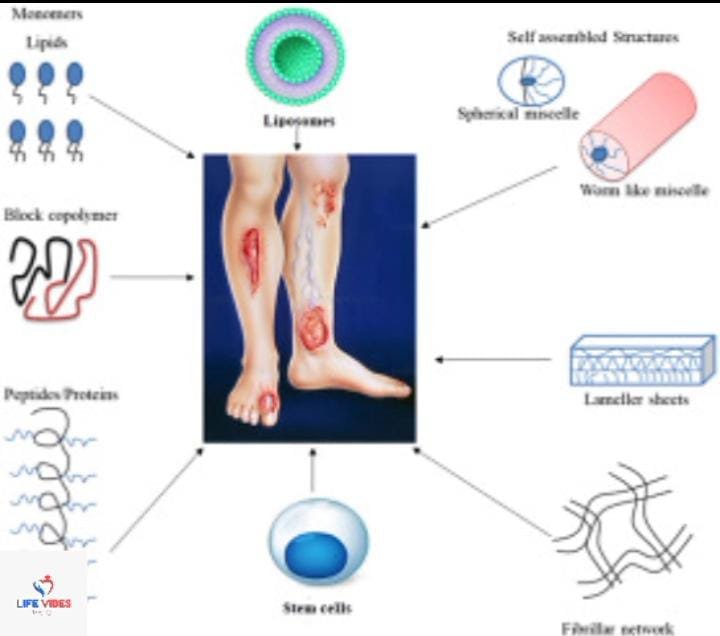Innovations In Healing: The Future Of Chronic Wound Management
Innovations in healing the future of chronic wound management, Ongoing injuries, those that neglect to recuperate inside a sensible time span, represent a critical test to medical services frameworks around the world. They frequently come about because of basic circumstances like diabetes, vascular inadequacy, and strain ulcers, and can prompt serious entanglements, including removal and contamination. Nonetheless, progressions in innovation and exploration are upsetting the field of wound care, offering expect patients and medical services suppliers the same.

Wounds and the Healing Process
An injury is a break in the skin or different tissues of the body. It very well may be brought about by different elements, including wounds, surgeries, or hidden ailments. The mending system is an intricate series of occasions that includes fixing harmed tissues and reestablishing the skin’s respectability.
Kinds of Wounds
Wounds can be characterized in view of their seriousness and cause:
Intense Wounds:
These injuries recuperate inside an anticipated time span and ordinarily don’t have hidden ailments. Models incorporate cuts, scratches, and stabbings.
Chronic Wound:
These injuries neglect to mend inside a sensible time span, frequently because of fundamental ailments or confusions. Models incorporate diabetic ulcers, pressure ulcers, and venous balance ulcers.
Innovations In Healing: The Future Of Chronic Wound Management
Understanding of Chronic Wound
Prior to diving into the advancements, getting a handle on the intricacies of constant wounds is fundamental. These injuries are described by hindered recuperating processes, frequently because of elements, for example, unfortunate blood stream, disease, and tissue harm. Customary medicines, while successful at times, frequently battle to address the hidden causes and advance ideal recuperating.
Advance in Wound Care Innovation/ Technology
Smart Dressings:
The fate of wound care is progressively computerized. Savvy dressings, outfitted with sensors and high level materials, can screen twisted conditions continuously. These dressings can recognize changes in temperature, pH, and dampness levels, giving significant information to medical care suppliers. A few dressings even integrate antimicrobial properties to assist with forestalling contamination’s.
3D Bio-printing:
Envision making custom tissue substitutions that impeccably match a patient’s requirements. 3D bio-printing innovation is making this a reality. By utilizing bio-compatible materials and living cells, specialists can print skin joins, veins, and even organs that can be utilized to treat persistent injuries. This innovation holds the commitment of customized medication and sped up mending.
Stem Cell Treatment:
Immature microorganisms, undifferentiated cells with the possibility to become different cell types, are being investigated as a promising therapy for ongoing injuries. By acquainting undeveloped cells with the injury site, scientists plan to animate tissue recovery and advance recuperating. This approach has shown promising outcomes in clinical preliminaries.
Hyperbaric Oxygen Treatment:
This includes presenting patients to high groupings of oxygen in a compressed chamber. Hyperbaric oxygen treatment can upgrade blood stream to the injury, further develop tissue oxygenation, and advance recuperating. It is especially viable in treating diabetic ulcers and strain ulcers.
Negative Strain Wound Treatment (NPWT):
NPWT includes applying delicate attractions to the injury, eliminating liquids and trash while advancing tissue development. This procedure has been displayed to lessen mending time and work on injury conclusion.
6.Skin Grafts
Skin unites are considered as a treatment choice on the off chance that an injury is enormous to the point that it can’t close all alone. In this technique, skin is taken from one more piece of your body – as a rule your upper leg – and relocated to the injury. There are additionally joins that are produced using human cell items and manufactured materials. Skin unites increment the opportunities to ineffectively recuperate venous leg ulcers shutting quicker. Ongoing foot wounds (ulcers) in individuals with diabetes likewise mend quicker after a skin unite.

The Role of Advanced Wound Care Communities/Center
High level injury care focuses assume a critical part in giving specific consideration to patients with persistent injuries. These focuses frequently utilize a multidisciplinary group of medical services experts, including doctors, attendants, and wound care trained professionals. They use cutting edge innovations and proof based practices to upgrade patient results. Innovations In Healing: The Future Of Chronic Wound Management
Future Directions in Chronic Wound Management
The field of constant injury the executives is quickly developing, driven by head-ways in innovation, research, and a more profound comprehension of the hidden natural cycles engaged with recuperating. As medical services suppliers look to work on persistent results and diminish the weight of constant injuries, a few promising roads are arising:
Customized Medication and Accuracy Wound Care:
Hereditary Investigation: Distinguishing hereditary variables that impact wound mending can prompt custom fitted treatment plans.
Biomarkers: Checking explicit biomarkers can assist with foreseeing mending rates and recognize possible inconveniences.
Customized Dressings: The advancement of dressings that adjust to individual injury qualities can improve mending.
Immature microorganism Treatment and Regenerative Medication:
High level Immature microorganism Conveyance: Novel methods for conveying undeveloped cells to wound locales, like utilizing hydro-gels or micro-spheres, can work on their viability.
Tissue Designing: Making bio-engineered tissues and organs to supplant harmed tissue can alter wound care.
Blend Treatments: Incorporating undeveloped cell treatment with different medicines, similar to development factors or bio-materials, can upgrade recuperating results.
Nanotechnology and Smart Wound Dressings:
Drug Conveyance Frameworks: Nanotechnology can empower controlled arrival of remedial specialists, working on injury recuperating and lessening the gamble of disease.
Sensors and Observing: Shrewd dressings furnished with sensors can screen twisted boundaries progressively, taking into account convenient acclimation’s to treatment.
Antimicrobial Coatings: Nanomaterials can be integrated into dressings to give antimicrobial properties and forestall contamination’s.
AI and Machine Learning :
Prescient Investigation: man-made intelligence calculations can break down persistent information to foresee recuperating results and distinguish likely difficulties.
Picture Examination: AI can help with dissecting twisted pictures to evaluate mending progress and distinguish irregularities.
Treatment Streamlining: artificial intelligence controlled stages can assist with advancing treatment plans in light of individual patient attributes and wound conditions.
Bio-materials and High level Injury/Wound Care Items:
Biodegradable Materials: Creating biodegradable dressings that imitate the regular injury recuperating climate can advance tissue recovery.
Functionalized Materials: Integrating bio-active atoms, for example, development elements or antimicrobial specialists, into wound care items can improve recuperating and lessen the gamble of contamination.
3D Printing: 3D printing can be utilized to make altered injury dressings and platforms custom fitted to individual patient necessities.
Mark of-Care Diagnostics and Telehealth:
Quick Testing: Mark of-care diagnostics can empower fast evaluation of wound boundaries, like contamination status or tissue oxygenation.
Telehealth Conferences: Telehealth can further develop admittance to specific injury care, particularly in distant regions.
Innovations In Healing: The Future Of Chronic Wound Management

Periods of Wound Healing
The mending system is separated into four particular stages:
Hemostasis: This is the underlying stage that happens following the injury. Veins tighten to limit blood misfortune, and platelets structure a coagulation to quit dying.
Incendiary stage: This stage starts inside a couple of hours of the injury and goes on for a few days. White platelets and other incendiary cells relocate to the injury site to tidy up flotsam and jetsam and fend off contamination.
Proliferative stage: During this stage, new tissue starts to develop to fill the injury hole. Fibro-blasts produce collagen, a protein that assists with framing scar tissue. Veins additionally recover to supply oxygen and supplements to the mending tissue.
Renovating stage: This is the last period of mending, which can keep going for a considerable length of time. Scar tissue is redesigned and reinforced, and the injury continuously closes.
Factors Influencing Wound Healing
A few variables can impact the recuperating system, including:
Age: More seasoned people might have more slow mending rates because of diminished blood stream and decreased tissue flexibility.
Basic ailments: Conditions like diabetes, vascular infection, and unfortunate nourishment can weaken recuperating.
Contamination: Diseases can postpone recuperating and increment the gamble of confusions.
Sustenance: Sufficient admission of supplements, like protein, nutrients, and minerals, is fundamental for ideal recuperating.
Smoking: Smoking can lessen circulatory system and hinder repairing.
Drugs: Certain remedies, similar to blood thinners and corticosteroids, can dial back recovering.
Complications of Wounds
In the event that an injury doesn’t mend as expected, it can prompt different entanglements, including:
Disease: Microorganisms can attack the injury and cause a contamination.
Tissue rot: In the event that blood stream to the injury is lacking, the tissue can kick the bucket.
Dehiscence: This happens when the injury returns.
Fistula: A fistula is an unusual path between two organs or between an organ and the beyond the body.
Innovations In Healing: The Future Of Chronic Wound Management
What are the pain management options?
Excruciating constant injuries can be a weight in day to day existence and furthermore keep you from getting a decent night’s rest. Steady torment can truly wear you out, causing you to feel very low or even discouraged inevitably.
It frequently harms while the dressing is changed as well, especially in the event that the dressing is adhered to the injury. Yet, this aggravation can be diminished in different ways – for example, by utilizing dressings that are more averse to adhere to the injury. The injury can likewise be flushed with a salt arrangement first, so the dressing falls off more without any problem.
Drugs like acetaminophen (paracetamol) or ibuprofen can help ease gentle to direct agony. A few dressings contain pain relievers as well. In the event that they aren’t sufficiently powerful, the specialist can recommend a more grounded pain reliever.
Individuals who have constant agony can profit from torment the executives treatment and mental help. The point of mental medicines for torment the board is to assist with peopling adapt better to the aggravation in daily existence.
Innovations In Healing: The Future Of Chronic Wound Management
Conclusion
The eventual fate of ongoing injury the executives is splendid. With continuous progressions in innovation and examination, we can hope to see much more imaginative methodologies that work on the existences of patients experiencing these crippling circumstances. By joining conventional injury care rehearses with state of the art treatments, medical services suppliers can offer expect a future where ongoing injuries are at this point not a huge weight. Innovations In Healing: The Future Of Chronic Wound Management
For further you can visit: Hero Instinct 12 Word Text Revealed With Examples

[…] Read moreInnovations In Healing: The Future Of Chronic Wound Management […]